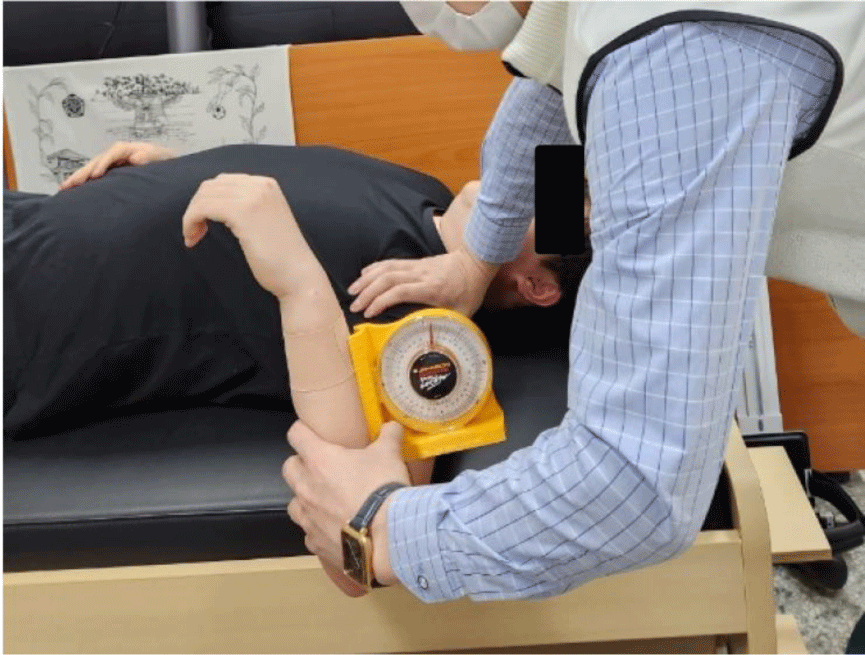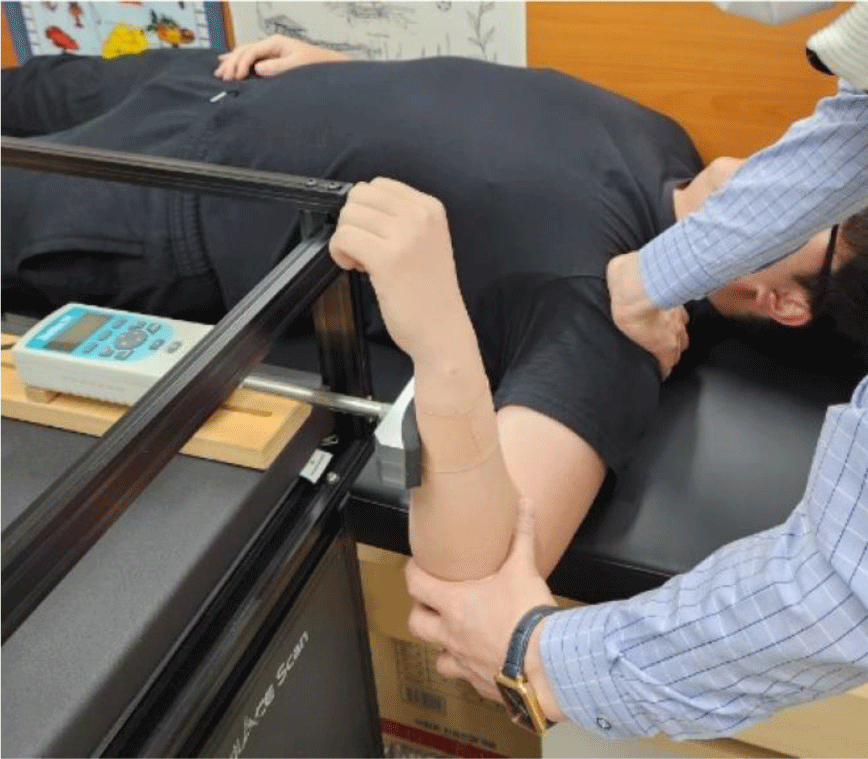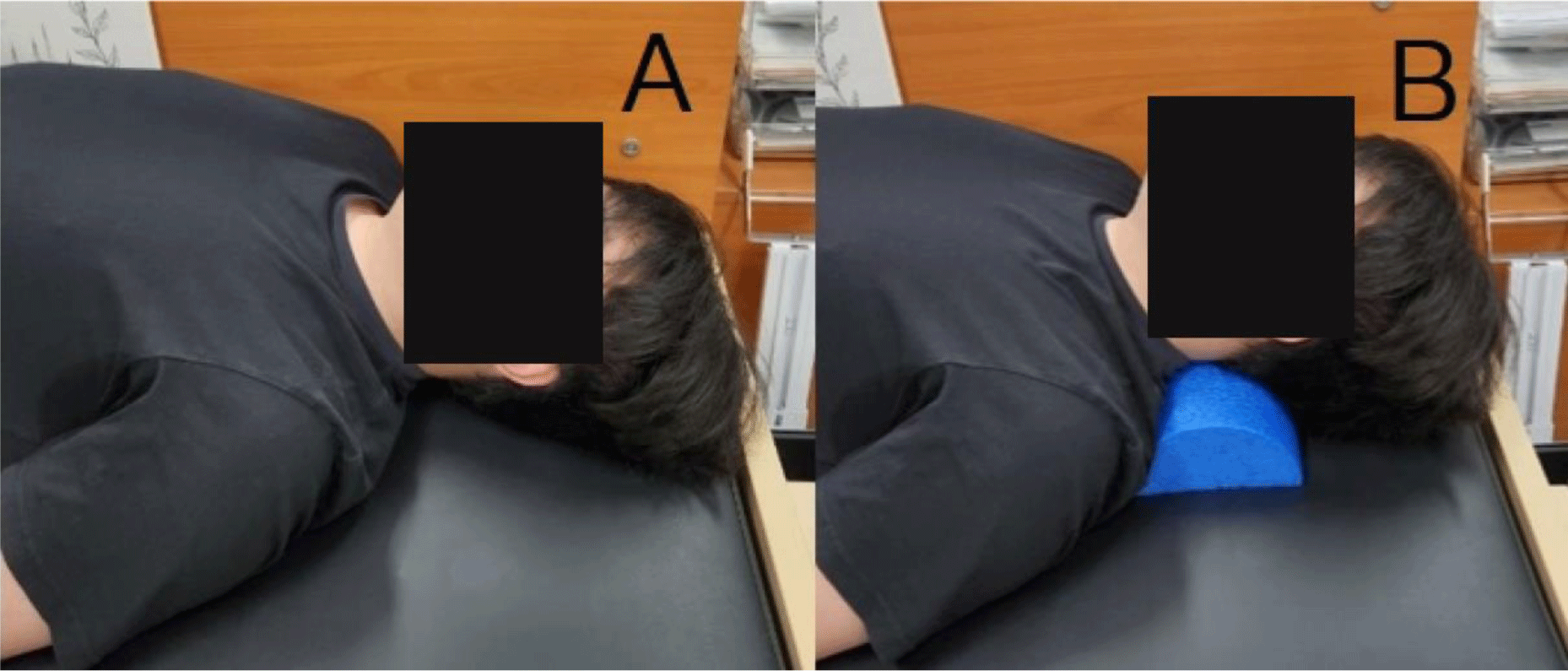INTRODUCTION
Abnormal neck posture, such as forward head posture (FHP), is a common cause of cervical and shoulder pain, affecting approximately two-thirds of people at least once in their lifetime.1 FHP is characterized by forward head position and hyper-extended upper cervical joints.2,3 Although many factors affecting the progression of FHP are known, excessive monitor work, mobile phone use, and the lack of neck and shoulder range of motion (ROM) and strength exercises are known to be the major causes of FHP.4,5 FHP progression leads to musculoskeletal dysfunction, such as intervertebral disc herniation, stenosis of the various vertebral foramen, deformation of the ligament flavum, neck pain, and osteoarthritis of the cervical facet joints.6-9 In addition, if abnormal head and neck posture such as FHP is not managed, it can result in height reduction, decreased quality of life, limited neck motion, shoulder pain, chronic headaches due to blood vessel compression in stiff neck muscles, musculoskeletal disorders, such as upper crossed syndrome, and muscle imbalance.10,11 The neck and shoulder regions are anatomically close, and various muscles are affected by posture and the movement of the neck and shoulders, such as the upper trapezius, levator scapula muscle, sternocleidomastoid, and scalene muscles.12 FHP produces shortening and hypertension of the levator scapulae, pectoralis minor, pectoralis major, and upper trapezius, which elicits elevation of the scapula and round shoulder deformation that negatively affect shoulder joint movement and muscle strength.13,14
Among the various movements of the glenohumeral joint occurring in a three-dimensional (3D) space, internal rotation (IR) and external rotation (ER) movements play an important role in performing the activities of daily living.15 People with FHP showed abnormal electromyographic (EMG) activity in the neck muscles, and it was reported that shoulder muscles, such as the serratus anterior and trapezius muscle, were also negatively affected.12,16 Objective and quantitative clinical investigations are important in determining the precise diagnosis for patients with musculoskeletal dysfunctions, such as FHP and neck problems.2,7 Many previous studies related to FHP and the kinesiologic function of the shoulder complex reported the effects of FHP on EMG activity of the shoulder muscles, such as the upper trapezius, serratus anterior, or lower trapezius.12,16 Although high-quality kinetic and kinematic evaluations, such as a 3D motion analysis and EMG devices, are used to investigate the relationship between FHP and shoulder dysfunction, most of the studies have mainly focused on shoulder muscle activity or neck pain.2,3,16 In addition, studies verifying the effect of artificial FHP on the kinetics and kinematics of the shoulder joint using internal and external movement tasks are insufficient.
Currently, one of the major joints that are intensively treated in clinical physical therapy is the shoulder joint.17 Since the shoulder complex undergoes many movements even in simple daily activities, functional limitations occur easily compared to other musculoskeletal joints and segments.18 Thus, it is important to maintain upper limb function to continue independent daily living. Therefore, the purpose of this study was to investigate the effects of artificial FHP on internal and external rotator strength and the ROM of the glenohumeral joint using a dynamometer and inclinometer in healthy individuals. It was hypothesized that shoulder strength and shoulder joint ROM would be better when the participants were not under artificial FHP conditions.
METHODS
The participants were 29 healthy adults (12 males and 17 females) without any other neck and shoulder musculoskeletal problems. The participants were recruited using a university online bulletin and internet social network system. The exclusion criteria were: 1) a craniovertebral angle of 50 degrees or less measured using an electric inclinometer; 2) congenital deformity of the cervical and shoulder joints; 3) no history of serious surgical or neurological diseases; 4) no history of neck and shoulder traumatic injury in six months, and 5) limited ROM of the shoulder joint.3 All participants voluntarily participated and were given a precise explanation of the experimental procedures. The Institutional Review Board of Jeonju University approved the study design, and all participants were asked to provide written informed consent. The mean age, height, and weight of all participants were 24.6±3.2 years, 169.3±10.2 cm, and 65.9±10.5 kg, respectively.
A standard inclinometer was used to assess passive shoulder rotation ROM under each head condition (with and without FHP). For measuring ROM in both shoulders, the participants were asked to lie in the supine position on a firmly padded treatment plinth. The glenohumeral shoulder joint being measured was placed in 90° of abduction, the elbow joint was flexed to 90°, and the arm was passively moved by an examiner to elicit IR or ER of the shoulder joint (Figure 1). The investigator recorded the shoulder passive rotation ROM when a firm end-feel was noted. Three trials for each motion were performed with a rest period of approximately one minute between each trial. The mean values of the trials were used for statistical analysis. Previous studies reported an intra-class correlation coefficient (ICC) of 0.82–0.99 for intra-rater reliability when this technique was used to measure shoulder rotation ROM.19

Muscle strength data were obtained for left and right shoulder IR and ER muscles. The maximum isometric muscular peak force of the participants’ shoulder rotators was measured using a digital dynamometer (MSC-200, AMETEC Inc, FL, USA) with standardized manual muscle testing procedures and dynamometer placements (Figure 2).19,20 A wooden frame consisting of a platform (20 × 3 × 2.3 cm, width × length × height) and a vertical board (7.7 × 7.7 × 4.4 cm, width × length × height) was constructed to stabilize and fix the dynamometer. The measurement position of the shoulder rotator peak force was similar to that for the shoulder IR/ER ROM evaluation methods. After experimental setting to measure the shoulder IR/ER peak force, the participant was asked to push into the padded digital dynamometer for a duration of 5 seconds as hard as they could. Three trials for each strength test were performed with a rest period of approximately 2 minutes between each trial. The peak mean values of the trials were used for statistical analysis. An ICC for intra-rater reliability of 0.84– 0.91 using this technique for shoulder rotator strength assessment was previously reported.21

A medical tape was attached to the proximal 3 cm below the ulnar styloid process to measure both shoulder ROM and strength, and this tape point was designated as the measurement contact site for the inclinometer and dynamometer evaluations. A mobilization strap was fixed over the upper thoracic area to prevent trunk movement. The examiner pressed the front surface of the anterior acromion area with his hand to fix the scapula for precise measurement. To create an artificial FHP measurement condition, a half foam roll was placed behind the subject’s neck and head so that the earlobe protracted more than 1 inch forward from the acromion process (Figure 3).11,12 The participants not in FHP were asked to contact the neck and head naturally on the plinth floor for measurement without a half foam roll.

The Kolmogorov-Smirnov test was used to investigate whether the ROM and peak force data of the shoulder IR/ ER were normally distributed. Repeated-measures analysis of variance (ANOVA) with Bonferroni’s adjustment was used to compare ROM and strength data of the shoulder joint and both shoulder sides between FHP conditions. If the main effect (FHP condition or shoulder side) was significant, post-hoc testing was used for pairwise comparisons based on the ANOVA results. All analyses were conducted using SPSS version 26.0 (IBM Corp., Armonk, NY, USA). Differences were considered significant at the α=0.05 level.
RESULTS
The mean and standard deviations of the general characteristics of the participants are shown in Table 1. There was a significant difference in ER ROM values in and not in FHP conditions during passive ROM examination (F=6.833, p=0.004) (Table 1). The IR ROM value (F=8.170, p=0.002) differed significantly according to the shoulder side (Table 1). The interaction effects between FHP conditions and shoulder sides for any rotation ROM values were not significant (p>0.05) (Table 1). Comparison results of peak force of the shoulder internal and external rotator between FHP conditions and shoulder sides, there was significant difference in external rotator maximal strength value between with and without FHP conditions (F=5.724, p=0.008) (Table 2). However, the shoulder sides and interaction effects between FHP conditions and shoulder sides for any rotation ROM values were not significant (p>0.05) (Table 2).
(N=29)
(N=29)
The post-hoc test showed significant differences in ER ROM of the right shoulder joint (p=0.004) and an external rotator peak force of the right (p=0.008) and left (p=0.024) shoulder joints between FHP conditions (Table 3).
(N=29)
DISCUSSION
The current study was executed to verify the clinical characteristics of shoulder rotation ROM and isometric peak force with and without artificial FHP in the supine position. It is essential to understand the clinical characteristics that occur in the shoulder joints during daily living in individuals with FHP to plan and manage a benign therapeutic procedure for FHP with musculoskeletal problems, such as neck and shoulder pain.12,22,23 The current study measured the kinematic IR/ER ROM and kinetic peak force values of both shoulder joints using tools that could be easily used in clinical practice.19,20 In addition, in order to verify the effect of IR and ER occurring in the glenohumeral joint according to with and without FHP, the experimental procedure was conducted in the supine position to fix and limit the scapular movement as much as possible. The results of the study showed significant increases in the ER ROM value of the right shoulder when not in FHP compared to in FHP. Although the ER ROM value of the left shoulder was not statistically significant, it showed an increasing trend when not in FHP compared to when in FHP. The isometric peak force variables of the shoulder external rotator were significantly increased in the FHP condition compared to conduction when not in the FHP condition.
The current results showed that FHP deformity affected shoulder rotation ROM and isometric peak force compared to no FHP. Significant changes were found in the ER ROM and ER peak force of the shoulder joint between FHP conditions. Although the current results cannot be directly compared to the outcomes of previous studies, Shin et al.24 verified the relationship between the neck disability index and visual analog scale scores to assess neck pain, shoulder joint ROM, and muscle strength in women with FHP.24 They reported a significant negative correlation between neck pain and shoulder joint ROM in ER, as well as a significant positive correlation between shoulder ER ROM and muscle strength in abduction. These results showed that FHP deformity negatively affected ER ROM and a muscle peak force of the shoulder joint. Although there were differences in study subjects and measurement tools, the present study also found that shoulder ER ROM was significantly decreased in the FHP condition compared to no FHP, which supports the results of a previous study by Shin et al. that the smaller the shoulder ROM ER value, the higher the neck pain. A prior study also reported that artificial FHP individuals showed significantly increased EMG activity in the upper trapezius and lower trapezius and significantly decreased EMG activity in the serratus anterior during loaded isometric shoulder flexion. They suggested that FHP may contribute to work-related neck and shoulder pain during loaded shoulder movement when performing the activities of daily living.12 Similarly the previous study, the present study also found a significantly increased change in the external rotator peak force of the shoulder joint according to FHP.
A number of previous studies reported that forward head posture altered shoulder joint kinematics. Kwon et al.25 reported abnormal changes in shoulder muscle activity in FHP compared to neutral head posture. Abnormal changes in neck alignment, such as FHP, cause changes in scapular alignment, and as a result, muscle activity of the serratus anterior muscle is reduced during shoulder flexion or overhead arm elevation movements. Similar to previous studies, our findings suggest that changes in neck alignment negatively affect shoulder muscle strength and ER ROM. FHP will also affect the overall posture of the body, causing negative changes in the muscle activity of related adjacent joints and segments. A previous study reported that head forward posture with neck pain was associated with changes in spinal alignment.26 Holmgren et al.26 reported that increased cervical lordosis with FHP created upper thoracic kyphosis and placed the shoulder rotator cuff tendon closer to the anterior acromion, increasing subacromial impingement. Therefore, the results of this study support the research hypothesis and clinical theory that people who maintain good head-neck alignment will show improved muscle strength and normal ROM when performing IR and ER of the shoulder joint. The current study results suggest that rotational movements of the shoulder joint should be considered along with FHP when treating these patients.
This study had some limitations. First, this study examined two artificial head and neck positions to confirm the effects on ROM and strength of the shoulder joint using simple clinical tools such as an inclinometer and a quantitative hand-held dynamometer. Second, this study examined the potential relationship between musculoskeletal problems of the shoulder joint and FHP deformity through a decrease in ER ROM value when applying an artificial FHP to healthy participants. Therefore, it is difficult to generalize the results of this study to FHP patients with neck and shoulder musculoskeletal disorders. Future studies are needed to verify the characteristics of patients with FHP with and without musculoskeletal problems, including neck and shoulder pain, using a reliable and objective evaluation method using a 3D motion capture system.
CONCLUSIONS
This study was executed to verify the effects of artificial FHP on internal and external rotator strength and ROM of the glenohumeral joint using a dynamometer and inclinometer, respectively. The results of this study indicated that FHP had a negative effect on rotation ROM and IR/ER muscle balance of strength of the shoulder joint, implying that it may act as a factor causing musculoskeletal problems in the neck and shoulder region. Therefore, maintaining correct head posture is important not only for intact of the neck but also for the health of the shoulder joint during assessment for healthy individuals without FHP. Educational training and therapeutic intervention will also be needed for this purpose.







